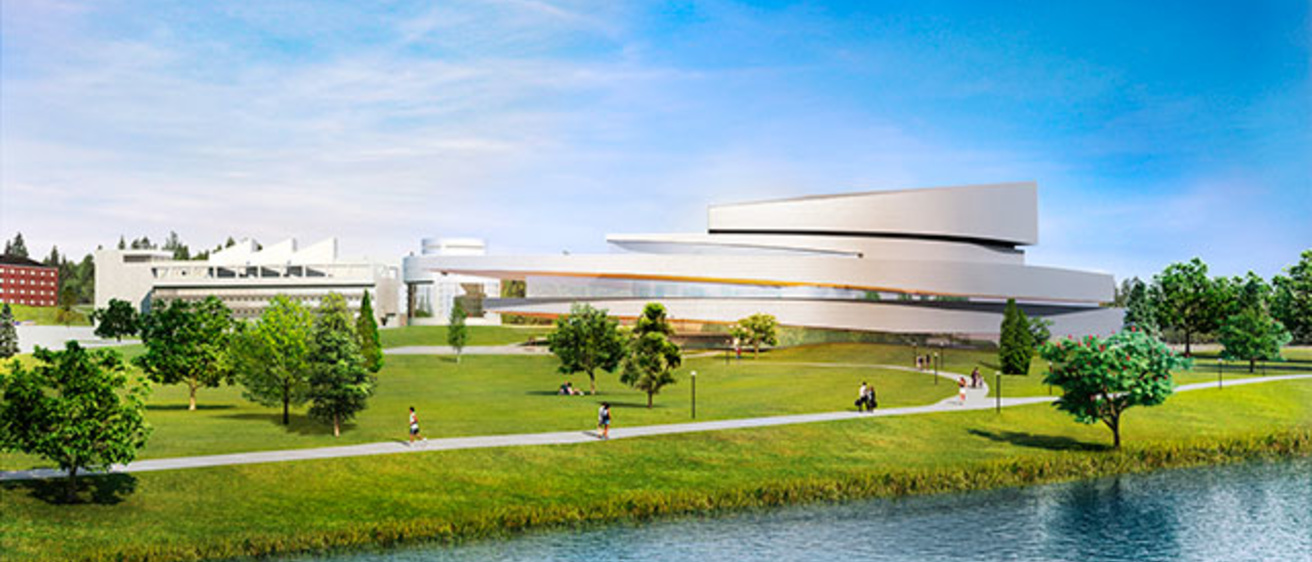Today it’s only a hole in the ground, but someday soon it will be a stunning, iconic and user-friendly Hancher Auditorium.
Moreover, the people who operate it will be doing business in new ways thanks to the partnerships they’ve formed with other arts organizations following the Flood of 2008, which rendered the original Hancher building useless and forced Hancher’s staff to find other venues for its artists and performances.
The University of Iowa will mark the start of work on replacement facilities for the School of Art and Art History, School of Music, and Hancher during Arts and Minds: A Celebration of Partnership, June 14 on the UI Pentacrest.
Read about other new UI arts facilities, including the forthcoming art building and music building.
“A new building is going to give us the opportunity to do the large-scale productions again, which we missed,” says Chuck Swanson, Hancher executive director. “But this time away from the old building has given us the opportunity to forge new partnerships and to think creatively about our programming. Being able to merge the new space and all of our new endeavors—I think it’s golden. It’s just terrific.”
Swanson is pleased that the team helping design the new building, from the architects to the contractors, have been excellent listeners and made the most of comments from Hancher staffers and others.
“One thing that’s allowed us to do a great job of planning is that we have 40 years of history,” he notes. “We’ve had the opportunity to think back and put more thought into the design so that it can be user-friendly.”
For example:
• The new theater will hold 1,800 seats, down from the 2,500 at the old building. There will be two balconies, but only eight rows in each. The result: a more intimate experience for artists and audiences. “The architect said that when we ended up with 1,800 seats, we hit a sweet spot architecturally, aesthetically, and acoustically,” Swanson explains.
• The stage itself will be smaller but still big enough for the large-scale productions that helped Hancher develop a well-deserved reputation. Storage behind the stage will be better organized and sited than at the old building.
• The site of the new building maintains the easy access from Interstate 80 and the plentiful parking, including close parking for persons with disabilities.
• Amenities such as the lobby, café, and outdoor terrace are being designed to encourage people to “come early and stay late,” Swanson says. “The lobby will lend itself to a social opportunity that our customers have been eagerly awaiting. And the views from the terrace, of the river and the campus, will be glorious.
“We didn’t even have a café when the original Hancher was built, but this time it’s very much a part of our thinking,” he adds. “I would love to see it available even outside of our performances. I see it as one of the hottest spots in town.”
• The new building includes a rehearsal space that promises to become a creative hub for UI students, faculty, the Hancher staff, and the many other artistic collaborators that Hancher has nurtured while operating without a building of its own.
“Take for instance our ‘Invisible Man’ project,” Swanson says. That project included UI faculty, students, a nationally known playwright, and more than a dozen UI offices and organizations. “We needed space for all of us to work together. This will make that possible.”
“The new Hancher will be iconic but very functional,” Swanson concludes. “We’ve struck the right balance between form and function. We’ve all waited so long—staff, artists, audiences, Iowans—that we want to squeeze every ounce of vitality out of it.”
